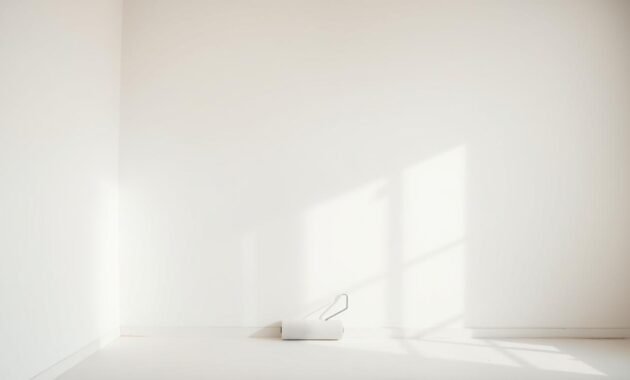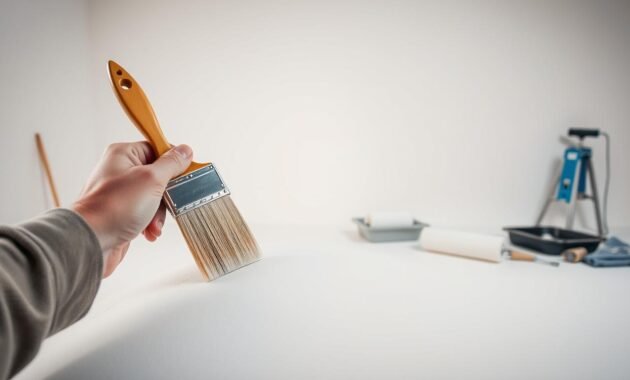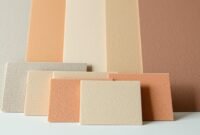Are you tired of paint that looks uneven or peels off too fast? Many people struggle to get a professional paint job. The key is knowing how many coats of primer you need for drywall.
Painting without priming can be a letdown. Your walls might soak up paint unevenly or show old colors. But, the right number of primer coats can make your walls look amazing.
I’ll show you how to pick the best primer strategy for your drywall project. Whether you’re covering dark colors, working with new surfaces, or aiming for a perfect finish, this guide will help. You’ll learn exactly how many coats of primer you need before painting.

Understanding the Importance of Primer in Painting Projects
Painting can change any space. But, getting a professional look needs more than just painting. Primer is key for a perfect finish, even on unfinished wood or rough surfaces.
Read also: How to Choose a Basement Waterproofing Sealer
What is Primer and Its Main Purpose
Primer is a coating that prepares surfaces for paint. It ensures paint sticks well and covers up surface flaws. This is very important when changing to a lighter color from a darker one.
- Provides a uniform surface for paint application
- Improves paint durability
- Helps cover existing colors or stains
- Reduces overall paint consumption
Why Primer is Essential for Surface Preparation
Painting without primer is like building on shaky ground. Primer seals surfaces, stopping paint from soaking in unevenly. This is critical for unfinished wood or surfaces with different textures.
Types of Primers Available
Each surface needs its own primer. Here’s a quick look at common types:
| Primer Type | Best Used On | Key Benefits |
|---|---|---|
| Water-Based Primer | Drywall, Wood | Easy cleanup, low odor |
| Oil-Based Primer | Wooden surfaces, Metal | Excellent stain blocking |
| Shellac Primer | Challenging surfaces | Superior stain coverage |
Knowing about primer helps you achieve a professional and lasting paint job. The right primer can turn an amateur finish into a polished one.
When You Can Skip Primer and When You Can’t
Deciding when to skip primer can be tricky. While priming is key for most painting projects, there are times when you might not need it. Knowing how many coats of primer you need depends on your painting situation.
I’ve learned that not all surfaces need the same primer treatment. Self-priming paints can be a big help in some cases. They work best when:
- Painting over existing painted walls in good condition
- Covering surfaces with minimal color change
- Working with clean, smooth surfaces
When it comes to new drywall, you usually need at least one coat of primer. But, there are exceptions. High-quality self-priming paints might let you skip a separate primer coat.
Read also: How to Fix Chipped Paint on Wall
| Surface Condition | Primer Recommendation |
|---|---|
| Painted walls in good condition | May skip primer |
| New drywall | Always use primer |
| Surfaces with stains or color changes | Primer is essential |
Skipping primer can cause poor paint adhesion, uneven color, and less durability. While it might save time, a proper primer application can save money and frustration later.
Pro tip: Always check your surface before deciding to skip primer. If unsure, it’s best to apply a coat of primer for the best painting results.
Factors That Determine How Many Coats of Primer You Need
Choosing the right number of primer coats isn’t simple. Many factors influence how many coats you’ll need for your project. Let’s explore the main considerations to help you decide.
When planning your primer coats, it’s important to look at three key areas:
- Surface Material Variations
- Existing Color Background
- Overall Surface Condition
Surface Material Considerations
Different materials need different primer approaches. For wood, the number of coats can vary a lot. Porous wood needs more primer for a smooth base. But, smooth surfaces like metal or already painted cabinets might need fewer coats.
Previous Paint Color Impact
The color of the surface you’re starting with is very important. Big color changes, like going from dark to light, often need more primer. Using a tinted primer can help with these big changes, reducing the number of coats needed.
Surface Condition Assessment
Surfaces with stains, patches, or uneven textures need extra care. These imperfections might need more primer coats for a uniform base. Always check your surface before starting to figure out how many coats you’ll need.
Single Coat Primer Scenarios
Knowing how many coats of primer you need can save you time and resources on your painting project. In some cases, just one coat of primer is enough to get your surface ready for painting.

When figuring out how many coats of primer you need, think about these situations where one coat is best:
- Painting over surfaces with similar existing paint colors
- Transitioning from light to dark paint colors
- Working with surfaces in excellent condition
- Priming clean metal surfaces
I suggest using a single coat of primer if your surface meets certain criteria. This includes smooth walls without damage, uniform color backgrounds, and minimal texture variations. Professional painters often say one coat is enough for simple painting jobs.
| Surface Type | Primer Coat Recommendation | Key Considerations |
|---|---|---|
| Clean Drywall | Single Coat | Smooth surface, no visible imperfections |
| Metal Surfaces | Single Coat | Clean, rust-free, minimal oxidation |
| Light Color Transition | Single Coat | Minimal color difference between existing and new paint |
When applying your single coat of primer, make sure to cover evenly and let it dry properly. The right application technique is key to getting the best results with just one coat.
How Many Coats of Primer for Different Surface Types
Painting surfaces needs a careful plan for priming. Each material is different, affecting how many primer coats are needed. I’ll share key tips for various surfaces to get a top-notch finish.
New Drywall Priming Requirements
For new drywall, use a PVA (polyvinyl acetate) primer. It usually needs two coats to:
- Seal the surface
- Make a uniform base for paint
- Help paint stick better
- Stop too much paint from soaking in
Wood Surface Priming Guidelines
Wood surfaces usually need two coats of primer. Unfinished wood soaks up primer differently. So, multiple coats make the surface smooth and even. Choose a good wood primer that:
- Seals wood pores
- Stops wood tannins from showing through
- Provides a solid base for paint
Metal Surface Recommendations
Metal surfaces, like car parts, usually need two coats of primer. They require special care to avoid rust and ensure paint sticks well.
| Surface Type | Recommended Primer Coats | Key Considerations |
|---|---|---|
| New Drywall | 2 coats | Use PVA primer, seal porous surface |
| Unfinished Wood | 2 coats | Prevent tannin bleed, create smooth base |
| Metal Surfaces | 2 coats | Prevent rust, improve paint adhesion |
Pro tip: Let each primer coat dry fully before adding the next. This ensures the best surface prep and a professional paint job.
Double Coat Primer Applications
When you’re painting furniture or cabinets, knowing how many coats of primer you need is key. I’ve learned over the years that some surfaces need two coats of primer. This is to ensure the paint sticks well and covers evenly.
Applying two coats of primer is vital in certain situations. For furniture and cabinets, it makes the surface smooth and even. This is important when:
- Covering dark or bold existing colors
- Working with porous or uneven surfaces
- Preparing wood or laminate surfaces for painting
- Trying to block stubborn stains or discoloration
When figuring out how many coats of primer for cabinets or furniture, consider these factors:
| Surface Type | Recommended Primer Coats | Reason |
|---|---|---|
| Wooden Furniture | 2 coats | Seal wood grain and create smooth base |
| Kitchen Cabinets | 2 coats | Ensure complete coverage and durability |
| Previously Painted Surfaces | 1-2 coats | Depends on color and surface condition |
Pro tip: Always let each primer coat dry fully and lightly sand between coats. This helps the paint stick better and look professional.
Special Cases Requiring Three Coats of Primer
Most painting jobs need one or two coats of primer. But, there are times when you’ll need three coats of PVA primer. Knowing when this is necessary can help you get a professional finish and protect your surfaces well.
Deciding on the number of primer coats depends on a few key factors. Usually, two coats are enough. But, some surfaces need an extra layer for protection.
Dealing with Major Stains
Stubborn stains can be tough for painters. For big stains or water damage, a third coat of primer is key. Here are some situations where you’ll need extra primer:
- Water damage on ceilings or walls
- Extensive smoke or nicotine stains
- Severe rust marks on metal surfaces
- Deep ink or marker stains
Covering Dark Colors
Changing walls from dark to light colors is a challenge. Dark paint colors need more effort to cover fully. When moving from deep colors to lighter ones, a third primer coat might be needed for full coverage.
Pro tip: Always let each primer coat dry fully before adding the next. This ensures the best adhesion and a smooth paint finish. If you’re unsure, talk to a professional paint specialist for advice.
Best Practices for Primer Application
Getting a smooth surface starts with the right primer application. The way you apply it can turn a job from amateur to professional. It’s all about the technique.
Here are some key tips for using your primer effectively:
- Stir the primer well before you start to get even color and texture.
- Pick the right tool for your surface:
- Brushes for details and edges
- Rollers for big, flat areas
- Sprayers for big or rough surfaces
- Use even strokes to apply primer for a smooth finish.
- Let each coat dry fully before adding more (follow the maker’s advice).
Always check the primer label for specific instructions. Different surfaces need different methods. If you’re not sure, ask a pro at your local hardware store for help.
Clean your tools right after you use them. This keeps them in good shape for your next project. Taking care of your tools is as important as how you use them.
Common Mistakes to Avoid When Priming
Priming might seem simple, but even pros can make mistakes. Knowing these can save you time, money, and stress in your painting projects.
From my years of painting, I’ve learned that avoiding common errors is key. It’s what keeps your project on track.
Improper Surface Preparation
Getting your surface ready is vital, whether it’s unfinished wood or light colors. Skipping important steps can ruin your paint job and look unprofessional.
- Failing to clean surfaces thoroughly before priming
- Neglecting to sand rough areas
- Ignoring existing damage or imperfections
- Not removing old paint or loose debris
Wrong Primer Selection
Choosing the wrong primer can ruin your project. Different surfaces need different primers for the best results.
- Always match primer to your specific surface material
- Consider the existing color and surface condition
- Select primers designed for unfinished wood or light color transitions
- Check compatibility with your final paint color
By steering clear of these mistakes, you’ll get a paint job that looks great and lasts long.
Tips for Achieving Professional Results

As a professional painter, I’ve learned that mastering how many coats of primer is key. The secret to a flawless finish is knowing how to apply primer and paint.
Here are some insider tips for that professional-grade look:
- Always start with a clean, smooth surface before applying primer
- Use high-quality rollers and brushes for even coverage
- Check lighting to ensure complete and consistent application
- Allow proper drying time between each coat of primer
When figuring out how many coats of primer to use, consider these factors:
- Surface porosity
- Previous color intensity
- Material you’re painting
- Desired final color appearance
Pro tip: For tough surfaces like dark-colored walls or porous materials, you might need more primer coats. Don’t rush it – patience is key for a professional-quality finish.
If you’re unsure about your technique or the number of primer coats needed, consider getting help from a professional painter. They can give you personalized advice for your project.
Time Management Between Primer Coats
When you’re deciding how many coats of primer to use, timing is key. The drying time between coats can greatly affect your painting project. Let’s explore how to manage your primer application well.
The drying time depends on several important factors. These include:
- Room temperature
- Humidity levels
- Type of primer used
- Surface material
Most primers take about 1-3 hours to dry fully. Always check the manufacturer’s instructions. Some primers might need different drying times.
| Primer Type | Average Drying Time | Recoat Time |
|---|---|---|
| Water-based Primer | 1-2 hours | 2-3 hours |
| Oil-based Primer | 2-4 hours | 4-6 hours |
| Shellac Primer | 45 minutes | 1-2 hours |
Pro tip: Check if the primer is dry by lightly touching an area that won’t show. If it feels sticky or leaves a mark, wait longer. Good time management leads to a smooth, professional paint job.
Conclusion
Painting projects can seem daunting, but knowing how many coats of primer you need helps a lot. I’ve learned that priming is key for a professional finish. It’s not just an extra step.
We’ve looked at how to apply primer in this guide. It’s all about the surface you’re working with. Whether it’s new drywall or tough surfaces, the right primer coats make a big difference. It’s all about the surface’s texture, color, and condition.
My main point is that every painting job is different. You might need to adjust your plan. With the right prep, primer, and coats, your paint job will last and look great.
Painting is both an art and a science. Trust your instincts, take your time, and enjoy making your space beautiful.


